Point Charges and Accelerating a Charge
Movement of Electrically Charged Particles
- When an electrically charged particle is present in an electric field, it will undergo a force that causes it to move
- If an electrically charged particle is stationary in a uniform electric field, it will travel parallel to the electric field lines, either in the same direction as the field lines or in the opposite direction, depending on its charge
- When an electrically charged particle moves through a uniform electric field, such as between two parallel charged plates, it experiences a constant electric force and follows a parabolic trajectory
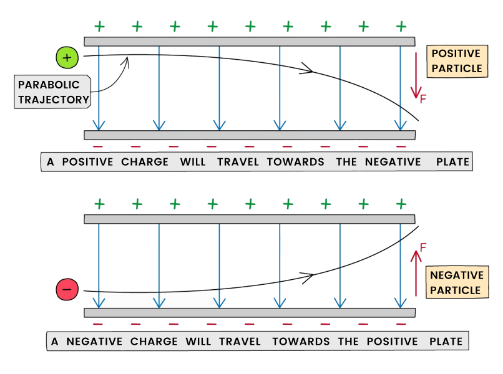
- The orientation of the parabolic trajectory is contingent on the charge of the particle
- A positively charged particle will be drawn towards the negatively charged plate and thus will undergo deflection in that direction
- Conversely, a negatively charged particle will be attracted to the positively charged plate and experience deflection in that direction
- The force acting upon the particle is constant and always acts in the same direction, regardless of the particle’s position
- Note: It should be noted that a neutral particle, like a neutron, does not experience any force within an electric field and, therefore, travels undeflected in a straight path through the plates
- The degree of deflection is influenced by several characteristics of the particle, such as:
- Mass – the greater the particle’s mass, the less pronounced its deflection will be, and vice versa.
- Charge – the greater the magnitude of the particle’s charge, the more pronounced its deflection will be, and vice versa.
- Speed – the faster the particle moves, the less pronounced its deflection will be, and vice versa.
Coulomb’s Law
- An electric field surrounds every charged particle
- Any other charged particle within the field’s reach experiences a force
- Coulomb’s Law defines the electrostatic force between two charges
- Remember that the charge of a uniform spherical conductor can be treated as a point charge located at its center
- According to Coulomb’s Law:
The force between two point charges is directly proportional to the product of their charges and inversely proportional to the square of the distance between them
- Coulomb’s equation is expressed as follows:
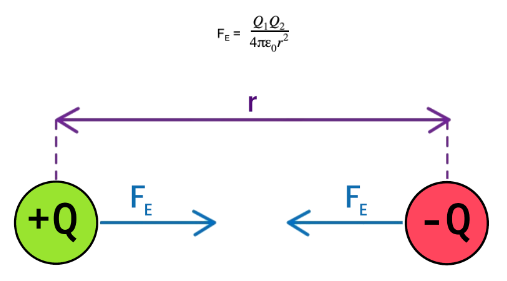
- Where:
- FE = which denotes the electrostatic force between the two charges, measured in Newtons (N)
- Q1 and Q2 = which represent the two point charges involved, measured in Coulombs (C)
- ε0 = which stands for the permittivity of free space
- r = which indicates the distance between the centers of the charges, measured in meters (m)
- The inverse square law refers to the relationship where the strength of a force decreases as the square of the distance increases
- Therefore, when the distance between two charges doubles, the electrostatic force between them reduces by a factor of (½)2 = ¼
- If a positive and a negative charge are present, the resulting electrostatic force is negative, indicating an attractive force between them
- Conversely, if the charges are the same, the electrostatic force is positive, indicating a repulsive force between them
- Coulomb’s law can be used to calculate the electrostatic force between uniformly charged spheres, provided that the distance between them is measured from the center of each sphere, treating them as point charges
Electric Potential
- To bring a positive charge closer to another positive charge, an external force is required to overcome the repulsive force between them
- Consequently, energy is transferred to the charge being pushed, resulting in an increase in its potential energy
- This increase in potential energy occurs due to the work done to bring the charges closer together
- When the repelling charge is free to move, it will move away from the other charge
- its potential energy will decrease back to zero
- This situation is comparable to the potential energy of a mass increasing when it is lifted upwards and decreasing as it falls due to gravity
- The electric potential at a given point can be defined as follows:
It is the amount of work done per unit positive charge required to bring a small test charge from an infinite distance to that point
- Electric potential is a scalar quantity, meaning that
- it lacks a directional component
- Despite this, electric potential is sometimes represented with a positive or negative sign to indicate certain properties, such as:
- A positive electric potential near an isolated positive charge
- A negative electric potential near an isolated negative charge
- A zero electric potential at an infinite distance from the charge
- The work done to move a test charge closer to a negative or positive charge is either negative or positive, respectively, which implies that:
- When a test charge is moved closer to a negative charge, its electric potential decreases
- Conversely, when a test charge is moved closer to a positive charge, its electric potential increases
- To determine the electric potential at a specific point due to multiple charges, the potentials due to each charge must be calculated and added together
Electric Potential of a Point Charge
- The electric potential within the field created by a point charge is characterized as:

- Where:
- V = electric potential (in volts, V) produced by the point charge
- Q = magnitude of the point charge producing the electric potential (in Coulombs, C)
- ε0 = permittivity of free space (in Farads per meter, F m-1)
- r = distance from the center of the point charge to the point where the electric potential is being measured (in meters, m)
- The Following Equation Describes the Behavior of a Positive (+) Charge:
- As the distance (r) from the charge decreases, the electric potential (V) increases
- This is due to the increased amount of work required to move a positive test charge against the repulsive force
- In Contrast, for a Negative (−) Charge:
- As the distance from the charge (r) decreases, the electric potential (V) decreases
- This is because less work is required to move a positive test charge towards the negative charge, as the attractive force aids in the movement
- Unlike the equation for gravitational potential, the negative sign in the electric potential equation is attributed to the charge itself
- The electric potential varies inversely with the square of the distance according to the inverse square law
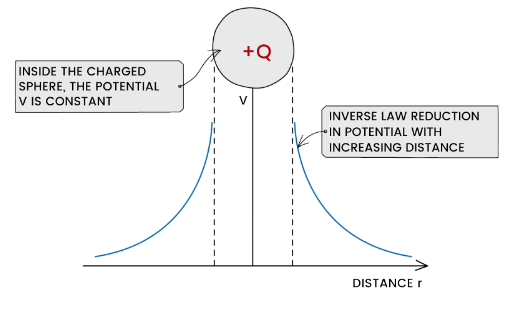
- It’s worth noting that this equation still holds true for a conducting sphere, where the charge on the sphere is considered to be concentrated at a point within the sphere based on the point charge approximation
Electric Field Gradient
- The variation of electric potential at different points in an electric field can be used to define the field itself.
Specifically, the electric field at a given point is equal to the negative gradient of the electric potential-distance graph at that point
- The potential gradient is characterized by the equipotential lines
- Which illustrate the electric potential within the field and are always depicted perpendicular to the field lines
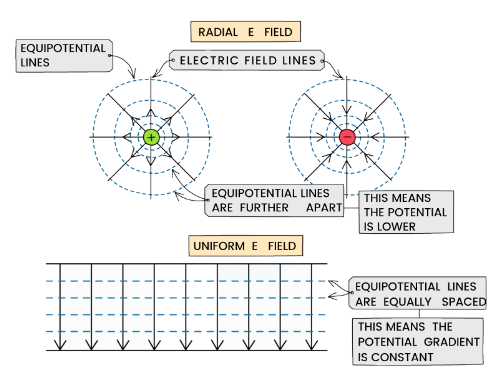
Perpendicular to electric field lines, the equipotential lines are formed around a radial or uniform field
- They indicate electric potential equality
- Around a radial field, concentric circles of increasing radius symbolize the equipotential lines that center around the charge
- The equipotential lines’ distance to one another grows
- For a uniform electric field, the equipotential lines are equally spaced
- The potential gradient in an electric field describes:
The electric potential’s rate of change concerning the displacement along the field direction
- The magnitude of the electric field is equal to the negative of the potential gradient:

- Where:
- E = electric field strength (V m-1)
- ΔV = change in electric potential (V)
- Δr = displacement in the direction of the field (m)
- The negative sign is important to ensure that the field is attractive around a negative charge and repulsive around a positive charge
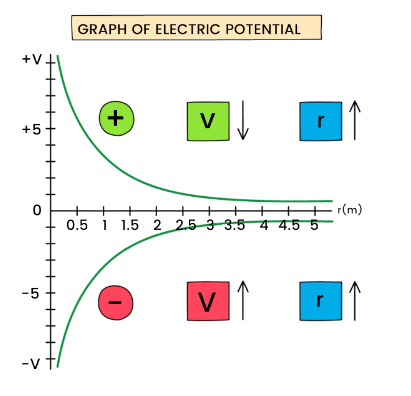
- The electric potential is dependent on the charge that creates the potential, and changes as the distance r increases from the center:
- When the charge is positive, the potential decreases with distance
- When the charge is negative, the potential increases with distance
- This phenomenon occurs because the test charge is positive
Calculation of Electric Potential Energy for Two Point Charges
- The electric potential energy (Ep) at a certain point within an electric field is determined by:
the work done to bring a charge from infinity to that point
- The electric potential energy between two point charges Q1 and Q2 can be calculated using the following equation:

- Where:
- Ep = electric potential energy (J)
- r = distance between the two charges Q1 and Q2 (m)
- ε0 = permittivity of free space (F m-1)
- The potential energy equation is derived from the work done in moving point charge Q2 from infinity towards point charge Q1.
- The work done can be calculated as:
W = VQ
- The following are the relevant parameters in this equation:
- W = represents the work done (J)
- V = represents the electric potential due to a point charge (V)
- Q = represents the charge that produces the potential (C)
- This equation can be used to calculate the work done on a charge in a uniform field
- Unlike the electric potential, the potential energy is always positive
- Note that when V is zero at infinity, Ep is also zero
- It is more useful to calculate the change in potential energy, such as when one charge moves away from another
- The change in potential energy for a charge Q1 at a distance r1 from the center of charge Q2, moving to a distance r2 away, can be expressed as:

- The change in electric potential, ΔV, is the same, but without the presence of the charge Q2

- The two equations bear resemblance to the change in gravitational potential that occurs between two points in the vicinity of a point mass
A point charge is a theoretical charge that is assumed to be concentrated at a single point in space. In reality, charges are spread out over a region, but the point charge approximation is often used for simplicity in calculations.
The force between two point charges can be calculated using Coulomb’s law: F = k * q1 * q2 / r^2, where F is the force, k is Coulomb’s constant (9 x 10^9 N*m^2/C^2), q1 and q2 are the magnitudes of the charges, and r is the distance between the charges.
Electric potential energy is the energy that a charged particle possesses due to its position in an electric field. It is calculated using the formula U = k * q1 * q2 / r, where U is the potential energy, k is Coulomb’s constant, q1 and q2 are the magnitudes of the charges, and r is the distance between the charges.
The electric field at a point due to a point charge can be calculated using the formula E = k * q / r^2, where E is the electric field, k is Coulomb’s constant, q is the magnitude of the charge, and r is the distance from the point charge.
The acceleration of a charged particle in a uniform electric field depends on the magnitude of the charge and the mass of the particle. The acceleration is proportional to the magnitude of the charge and inversely proportional to the mass of the particle.
The equation for the acceleration of a charged particle in a uniform electric field is a = q * E / m, where a is the acceleration, q is the magnitude of the charge, E is the electric field strength, and m is the mass of the particle.
Electric potential and electric field are related by the equation V = W / q, where V is the electric potential, W is the work done to move a charge q between two points in the field, and q is the magnitude of the charge.
AC (alternating current) electric fields periodically change direction and magnitude, while DC (direct current) electric fields have a constant direction and magnitude. AC electric fields are commonly used in household electricity, while DC electric fields are used in batteries and electronic circuits.






Still got a question? Leave a comment
Leave a comment